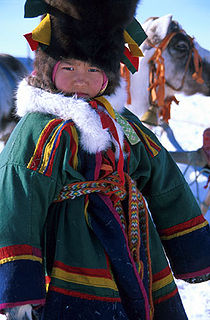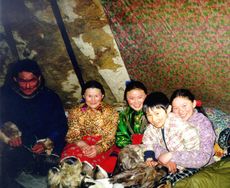Nenets people
 |
| Total population |
|---|
| 41,000 |
| Regions with significant populations |
| Russia |
| Languages |
|
Nenets, Russian |
| Religion |
| Related ethnic groups |
|
other Samoyedic peoples |
The Nenets people (ethnonym in Nenets: ненэця; Russian name: ненцы) are an indigenous people in Russia. According to the latest census in 2002, there are 41,302 Nenets in the Russian Federation, most of them living in the Yamalo-Nenets Autonomous Okrug and Nenets Autonomous Okrug. They speak either the Tundra or Forest varieties of Nenets.
Contents |
Name
Due to a false etymology,[1] the name Samoyed entered the Russian language as a corruption of the self-reference Saamod, Saamid (the Samoyedic suffix "-d" denotes plurality). In Russian ethnographic literature of the 19th century, they were also called "Самоядь", "Самодь", (samoyad', samod', samodijtsy, samodijskie narody) which was often transliterated into English as Samodi.
The literal morphs samo and yed in Russian convey the meaning "self-eater", which appears as derogatory. Therefore the name Samoyed quickly went out of usage in the 20th century, and the people bear the name of Nenets, which means "man".
When reading old Russian documents, it is necessary to keep in mind that the term samoyed' was often applied indiscriminately to different peoples of Northern Siberia who speak different Uralic languages: Nenets, Nganasans, Enets, Selkups (speakers of Samoyedic languages). Currently, the term "Samoyedic peoples" applies to the whole group of different peoples. It is the general term which includes the Nenets, Enets, Selkup, and Nganasan peoples.
Nenets are just a part of the Samoyedic peoples. Sometimes their name is spelled as Nenet, probably because of the erroneous assumption that the terminal 's' is for the plural number.
Language
Only three Nenets words have entered the English language: Nenets itself, Nganasan - an alternative name for the people, and parka, their traditional long hooded jacket made from skins and sometimes fur. Some 27,000 people speak the language.[2]
History and way of life
There are two distinct groups based on their economy: the Tundra Nenets (living far to the north) and the Khandeyar or Forest Nenets. The third group Kominized Nenets (Yaran people) has emerged as a result of intermarriages between Nenets and the Izhma tribe of the Komi peoples.
The Samoyedic languages form a branch of the Uralic language family, the other branch being the Finno-Ugric languages. It is of major importance for the basic comparison between the Uralic and Finno-Ugric languages. They moved (from farther south in Siberia) to the northernmost part of what later became Russia before the 12th century.

They ended up between the Kanin and Taymyr peninsulas, around the Ob and Yenisey rivers, with some of them settling into small communities and taking up farming, while others continued hunting and reindeer herding, travelling great distances over the Kanin peninsula. They bred the Samoyed dog to help herd their reindeer and pull their sleds, and European explorers later used those dogs for polar expeditions, because they have adapted so well to the arctic conditions. The Nenets gave the Polar Bear a special place in their religious life.[3] Tundra wolves can be a source of considerable economic loss, as they prey on the reindeer herds which are the livelihood of some Nenets families.[4] Fish was a major component of the Nenet's diet.
They had a shamanistic and animistic belief system which stressed respect for the land and its resources. They had a clan-based social structure. The Nenets shaman is called a Tadibya.
After the Russian Revolution, their culture suffered due to Soviet collectivisation policy. The government of the Soviet Union tried to force the nomad Samoyeds to settle down, and most of them became assimilated. They were forced to settle on permanent farms and their children were educated in state boarding schools, which resulted in erosion of their cultural identity. On the other hand, a wide range of new professions and activities were made available to the Nenets; Konstantin Pankov, for instance, became a well-known painter and Yuri Vella, though living as a reindeer herder, has become the first writer in Nenets. Environmental damage due to the industrialisation of their land and overgrazing of the tundra migration routes in some regions (Yamal Peninsula) have further endangered their way of life.
See also
- Music of Nenetsia
References
- ↑ http://education.yahoo.com/reference/dictionary/entry/Samoyed
- ↑ Games, Alex (2007), Balderdash & piffle : one sandwich short of a dog's dinner, London: BBC, ISBN 9781846072352
- ↑ Ian Stirling and Dan Guravich. 1998. Polar bears, 220 pages
- ↑ Heptner, V. G. & Naumov, N., P. (editors) Mammals of the Soviet Union Vol.II Part 1a, SIRENIA AND CARNIVORA (Sea cows; Wolves and Bears), Science Publishers, Inc. USA. 1998. ISBN 1886106819
 This article incorporates text from a publication now in the public domain: Chisholm, Hugh, ed (1911). Encyclopædia Britannica (Eleventh ed.). Cambridge University Press.
This article incorporates text from a publication now in the public domain: Chisholm, Hugh, ed (1911). Encyclopædia Britannica (Eleventh ed.). Cambridge University Press.
External links
- UNESCO Red Book on endangered languages
- Endangered Uralic Peoples
- Jarkko Niemi: The types of the Nenets songs. 1997
- Minority languages of Russia on the Net
- The Red Book of the peoples of the Russian Empire
- Historic-demographic note on the Nenets of the Komi Republic
- BBC: Nenets Tribe
- Photos of Nenets reindeer herders